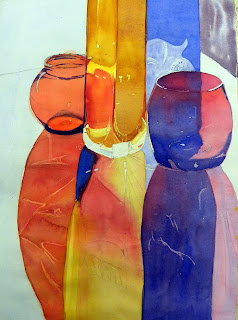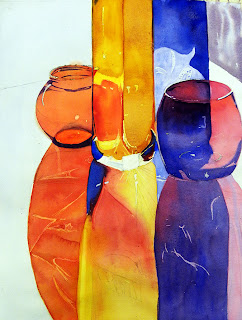On this the second to last class before we finish this piece, we are so much closer. There is still a ways to go.
 The image is beginning to have depth. This is achieved by darkening the values in specific areas.
The image is beginning to have depth. This is achieved by darkening the values in specific areas.
Using the primaries, mainly Windsor Red, Quinacradone Gold and French Ultramarine Blue we layer up each of the areas.
In the upper left hand corner we used wet in wet technique and applied our USA mixture. The upper right corner was darkened in the same way, just another layer over the previously painted section.
The middle reflection on the bottom was also completed wet in wet...be extremely careful here we used three primary colours and if not careful you can create mud...do not overwork the area.
Most of the mask has been removed now...the only areas that still have mask are the edges on the red vase and the pink glass. The highlights in the yellow vase and of course the white section at the bottom of the yellow vase.
In this last image we began to add the darkest darks to the right hand vases. Using Indigo or Indanthrone Blue, we added a layer over the sections of already dark blue.
Just a reminder before I close, to have fun, loosen up, use a larger thirsty brush, and breathe!
 The image is beginning to have depth. This is achieved by darkening the values in specific areas.
The image is beginning to have depth. This is achieved by darkening the values in specific areas. Using the primaries, mainly Windsor Red, Quinacradone Gold and French Ultramarine Blue we layer up each of the areas.
In the upper left hand corner we used wet in wet technique and applied our USA mixture. The upper right corner was darkened in the same way, just another layer over the previously painted section.
The middle reflection on the bottom was also completed wet in wet...be extremely careful here we used three primary colours and if not careful you can create mud...do not overwork the area.
Most of the mask has been removed now...the only areas that still have mask are the edges on the red vase and the pink glass. The highlights in the yellow vase and of course the white section at the bottom of the yellow vase.
In this last image we began to add the darkest darks to the right hand vases. Using Indigo or Indanthrone Blue, we added a layer over the sections of already dark blue.
Just a reminder before I close, to have fun, loosen up, use a larger thirsty brush, and breathe!







